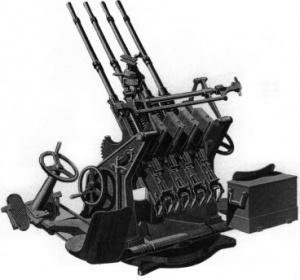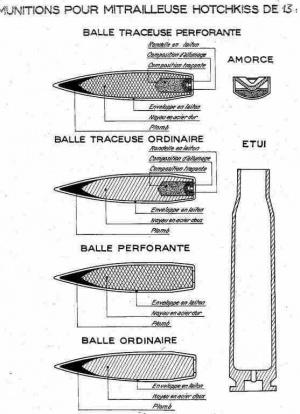Difference between revisions of "Hotchkiss Mle 1930 (13.2 mm)"
(→Available ammunition) (Tag: Visual edit) |
(corrected the typo and added up picture) (Tag: Visual edit) |
||
| Line 1: | Line 1: | ||
== Description == | == Description == | ||
| + | [[File:Hotchkiss Mle 1929.jpg|thumb|13.2mm Hotchkiss Mle 1929 in Naval quadmount]] | ||
''The Hotchkill Mle 1929 & Mle 1930 was French built heavy machine-gun used for multi-purpose. more commonly used as close anti-air defence by the French Navy, it was also commonly used by the French Infantry during the 30s until WW2. the guns was also adapted as main armament for tanks, armoured cars and anti-aircraft vehicles. it was for France the equivalent of the [https://wiki.warthunder.com/M2HB_(12.7_mm) 12.7mm M2HB]'' | ''The Hotchkill Mle 1929 & Mle 1930 was French built heavy machine-gun used for multi-purpose. more commonly used as close anti-air defence by the French Navy, it was also commonly used by the French Infantry during the 30s until WW2. the guns was also adapted as main armament for tanks, armoured cars and anti-aircraft vehicles. it was for France the equivalent of the [https://wiki.warthunder.com/M2HB_(12.7_mm) 12.7mm M2HB]'' | ||
| Line 11: | Line 12: | ||
=== Available ammunition === | === Available ammunition === | ||
| + | [[File:13.2mm Ammunition.jpg|thumb|main combat rounds for the 13.2mm Hotchkiss]] | ||
''Many ammunition are available for those guns, but not all of them are currently in the game'' | ''Many ammunition are available for those guns, but not all of them are currently in the game'' | ||
| Line 131: | Line 133: | ||
|} | |} | ||
| − | ==== '''Cartouche à balle ordinaire O or | + | ==== '''Cartouche à balle ordinaire O or AP type O''' ==== |
| − | it was a standard | + | it was a standard armour piercing rounds used against soft target such as infantry, unarmoured vehicles and aircraft. the projectile was made of carbon steel and was capped with lead. there was a brass cloak around the projectile. |
can be identify by the primer seal painted either Black or Purple | can be identify by the primer seal painted either Black or Purple | ||
| Line 149: | Line 151: | ||
==== '''Cartouche à balle perforante P or AP type P''' ==== | ==== '''Cartouche à balle perforante P or AP type P''' ==== | ||
| − | this round was | + | this round was a armour piercing hardened round used against armoured target. the projectile was made of alloy Tungsten-steel (3% tungsten, 97% steel) and was tempered. there was a lead cap and brass cloak on the rounds |
can be identify by primer seal painted Red | can be identify by primer seal painted Red | ||
| Line 159: | Line 161: | ||
==== '''Cartouche à balle traçante TO or AP-T type TO''' ==== | ==== '''Cartouche à balle traçante TO or AP-T type TO''' ==== | ||
| − | it was a | + | it was a armour piercing rounds equipped with a tracer tail. it have the same ballistic as the Type P |
can be identify by the primer seal painted Yellow | can be identify by the primer seal painted Yellow | ||
| Line 177: | Line 179: | ||
during the 30s, it was proposed for export as main armament of anti-aircraft truck. notably for Chile, but without success on export. | during the 30s, it was proposed for export as main armament of anti-aircraft truck. notably for Chile, but without success on export. | ||
| − | During the late 30s, the French cavalry had installed the 13.2mm on the AMR 35 ZT-1 to give the | + | During the late 30s, the French cavalry had installed the 13.2mm on the AMR 35 ZT-1 to give the reconnaissance vehicles a bit of anti-tank capacity in order to give it the capacity to defend themselves during their mission. |
the French Cavalry also mounted this gun on some of their Armoured car such as the Laffly 80AM | the French Cavalry also mounted this gun on some of their Armoured car such as the Laffly 80AM | ||
Revision as of 02:43, 26 July 2022
Contents
Description
The Hotchkill Mle 1929 & Mle 1930 was French built heavy machine-gun used for multi-purpose. more commonly used as close anti-air defence by the French Navy, it was also commonly used by the French Infantry during the 30s until WW2. the guns was also adapted as main armament for tanks, armoured cars and anti-aircraft vehicles. it was for France the equivalent of the 12.7mm M2HB
Vehicles equipped with this weapon
General info
the 13.2mm Hotchkiss offer a good and balanced performance against aircraft and soft targets, but have difficulty against vehicles with more than 20mm of armour. feed by 30 rounds magazine, it would often show a limited capacity to sustain a suppressing fire. the gun have a fire-rate of 450 Rounds minutes but it practice, it would seldom reach 20 Rounds minutes due to the reload and recoil
Available ammunition
Many ammunition are available for those guns, but not all of them are currently in the game
| Penetration statistics | |||||||
|---|---|---|---|---|---|---|---|
| Ammunition | Type of
warhead |
Penetration @ 0° Angle of Attack (mm) | |||||
| 10 m | 100 m | 500 m | 1,000 m | 1,500 m | 2,000 m | ||
| Type O | AP | 24 | 23 | 14 | 10 | 7 | 4 |
| Type OT | AP-T | 24 | 23 | 14 | 10 | 7 | 4 |
| Type P | APC | 28 | 27 | 23 | 21 | 19 | 17 |
| Type PT | APC-T | 28 | 27 | 23 | 21 | 19 | 17 |
| Shell details | |||||||||
|---|---|---|---|---|---|---|---|---|---|
| Ammunition | Type of
warhead |
Velocity
(m/s) |
Projectile
Mass (kg) |
Fuse delay
(m) |
Fuse sensitivity
(mm) |
Explosive Mass
(TNT equivalent) (g) |
Ricochet | ||
| 0% | 50% | 100% | |||||||
| Type O | AP | 810 | 0.051 | N/A | N/A | N/A | 66° | 70° | 72° |
| Type OT | AP-T | 810 | 0.051 | N/A | N/A | N/A | 66° | 70° | 72° |
| Type P | APC | 810 | 0.052 | N/A | N/A | N/A | 66° | 70° | 72° |
| Type PT | APC-T | 810 | 0.052 | N/A | N/A | N/A | 66° | 70° | 72° |
Cartouche à balle ordinaire O or AP type O
it was a standard armour piercing rounds used against soft target such as infantry, unarmoured vehicles and aircraft. the projectile was made of carbon steel and was capped with lead. there was a brass cloak around the projectile.
can be identify by the primer seal painted either Black or Purple
projectile weight : 51,2 g
Velocity : 810 m/sec
Cartouche à balle traçante TO or AP-T type TO
it was a standard rounds equipped with a tracer tail. it have the same ballistic as the Type O
can be identify by the primer seal painted Green
Cartouche à balle perforante P or AP type P
this round was a armour piercing hardened round used against armoured target. the projectile was made of alloy Tungsten-steel (3% tungsten, 97% steel) and was tempered. there was a lead cap and brass cloak on the rounds
can be identify by primer seal painted Red
projectile weight : 52 g
Velocity : 810 m/sec
Cartouche à balle traçante TO or AP-T type TO
it was a armour piercing rounds equipped with a tracer tail. it have the same ballistic as the Type P
can be identify by the primer seal painted Yellow
Comparison with analogues
12.7mm M2HB - Similar gun in performance but a lot more successful. it replace the Hotchkiss 13.2mm after WW2 for standardization purpose.
Type 93 (13.2 mm)- Japanese license copy
Breda Model 31 (13.2 mm) - Italian License copy
Usage in battles
The Hotckiss Mle 1929 was first used by the French navy in multiple guns mount. this armament was used by them to provide close anti-aircraft support in a range of 2500 m.
the gun was also carried by the Infantry in tripod as an heavy machine-gun.
during the 30s, it was proposed for export as main armament of anti-aircraft truck. notably for Chile, but without success on export.
During the late 30s, the French cavalry had installed the 13.2mm on the AMR 35 ZT-1 to give the reconnaissance vehicles a bit of anti-tank capacity in order to give it the capacity to defend themselves during their mission.
the French Cavalry also mounted this gun on some of their Armoured car such as the Laffly 80AM
Pros and cons
Pros:
- Good fire-rate
- Effective against soft target
- effective against aircraft
Cons:
- penetration a bit lacking
- Magazine of only 30-rounds
History
Developed by Hotchkiss & Cie in the middle of the 20s, the Hotckiss Mle 1929 was a multi-purpose heavy machine gun. first used by the French Navy, it was serving as close anti-air defence for the ships. the Army also adopted the gun, but in the Mle 1930 variants. thee difference was the Mle 1930 wasn't equipped with the sight and mount that allow the machine-gun to be used against the aircraft. the reason was the French army worry about the bullets might fall back on civilian area and potentially kill someone. the Army strictly used this armament as anti-tank and anti-infantry weapons in his official services. however, during the exile of the French army, and under Vichy regime, serial field modification appear mounting the 13.2mm Hotchkiss on truck. usually with Naval mount. those was usually used for convoy escort and anti-aircraft defence.
Media
Excellent additions to the article would be video guides, screenshots from the game, and photos.
See also
Links to the articles on the War Thunder Wiki that you think will be useful for the reader, for example:
- reference to the article about the variant of the cannon/machine gun;
- references to approximate analogues by other nations and research trees.
External links
Paste links to sources and external resources, such as:
| France anti-aircraft guns | |
|---|---|
| 13.2 mm | Hotchkiss Mle 1930 |
| 20 mm | GIAT M693/mod F2 · Oerlikon KAD (Swiss) |
| 30 mm | HSS 831A |
| 40 mm | Bofors L/60 · Mle. 1951 T1 (Bofors L/70) |





